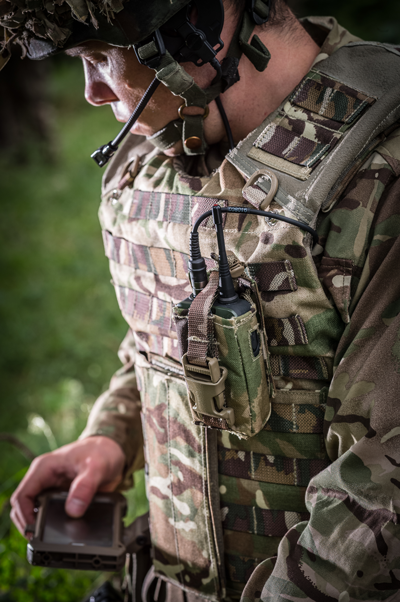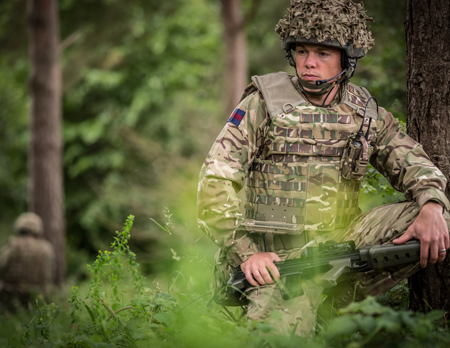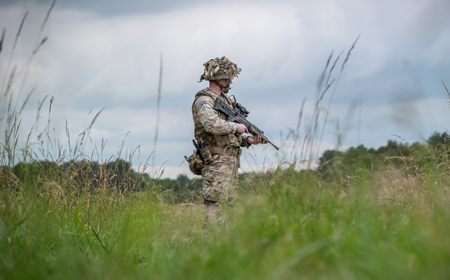How to choose a soldier radio that is fit for purpose

By Matt Hunt, Head of Sales – Land, Thales in the UK
The dismounted soldier today is a walking suite of complex electronics and interconnected systems of systems. Some people may believe that a radio, with a hub, end user device and headset is not very complicated, but the reality is that each of these sub systems are complex in their own right. The soldier is now trying to find a compromise between innovative capability and solutions for cabling, battery management and human machine interfaces, whilst at the same time learning to fight, live and sustain these systems in multiple environmental conditions and operational scenarios.
Government defence budgets, whilst increasing due to the current geopolitical tensions, are constrained. Many defence budgets are already committed to delivering large capital programmes such as the development of ships, planes and tanks for the next decade or more. This budget challenge does not negate the fact that tactical soldier radios are an essential piece of dismounted equipment. The fundamental need for boots on the ground in urban, desert and rural operations will remain unchanged in all forms of conflict and disaster management for decades to come.
The current pace at which technology is advancing, and our adversaries are developing counter measures such as jamming and spoofing, means that it is vital that radio systems maintain a pace of relevance in order to ensure that the security and integrity of information (voice and data) requirements are maintained. Secure and reliable communications between dismounted soldiers and adjacent dismounted and mounted units supports tactical battle winning information advantage and key strategic decision-making. In this article, I will share insights into what I consider to be key considerations when selecting radio systems for the modern day soldier.
Equipping Every Soldier- Today and Tomorrow
 When selecting a radio system, the goal should be to ensure that each soldier gets the most effective communications systems needed for their specific tasks, but with a set of ancillaries, applications and waveforms that enable agility and optimisation.
When selecting a radio system, the goal should be to ensure that each soldier gets the most effective communications systems needed for their specific tasks, but with a set of ancillaries, applications and waveforms that enable agility and optimisation.
Multiple radios are capable of supporting waveforms or additional functionality but in reality the willingness, cost and time required to undertake changes can be prohibitive. However, some radios have a proven ‘ever-greening’ capability so it is feasible to modify and field new waveforms in as little as a few months. This is becoming increasingly important as adversaries are developing dedicated techniques to detect, deny and disrupt current and existing radio communications. Radios with a flexible architecture can be adaptable through life, reducing the need to purchase entirely new radios in order to maintain pace with new technology on the battlefield.
Tracking and Location Functionality
Robust, secure voice communications are key to the intra team co-ordination of dismounted troops. In an increasingly digitised, high tempo battlefield, simple Blue Force Tracking (BFT) and shared situational awareness data is arguably one of the most important information aids to decision-making and safety. Added to this will be the need for low latency enemy positioning, battle group locations and mission plans - all information that will enrich the decision-making data available for commanders at all levels. To enable this, radios must have an advanced level of sophistication and agility in their architecture, with robust waveforms, providing configurable and mission-specific voice and data services, as well as latency minimised to near real time in order to support information superiority. Typically, the radio’s inbuilt Global Navigation Satellite System (GNSS) provides BFT data that is transmitted across the network, often at the same time as voice and imagery, with locations derived from other sources also transmitted in the same way if correctly networked.
It is not surprising then that many armed forces and uniformed services now consider BFT and target location sharing as key requirements of a modern soldier communication system, making these a must have feature of many modern radio networks.
Bandwidth
Radio spectrum is always in short supply and often allocated by collaborating nations. Therefore, the bandwidth your chosen radio occupies can be critical in determining whether you can fully deploy your communications capability or not. The trade-off generally is between more or less data. More data requires more spectrum. Narrowband solutions can be easier to deploy in the available spectrum and still provide all the services required. Does every soldier really need 4K Ultra High Definition Video? Narrowband radios can provide range without the networking overhead, but the compromise is that they can carry less data. A well-designed narrowband waveform alongside modern efficient coding techniques can deliver the BFT and other data requirements required to support Battlefield Management Applications (BMA). Narrowband waveforms can also simultaneously provide the multiple voice networks needed to support the command structure in a power and spectrum efficient package, which is difficult to detect on air (more on signatures and susceptibility later).
Size and Battery Power

The modern soldier is now a walking power management centre with a finite amount of power available for their different systems. If we imagine a soldier deploying into the field for 5 days and needing to sustain both themselves and all of their systems using only what they carry on their backs, this is not that far from the reality of operating in rural domains. Food, water, ammunition, batteries, weapon systems, and sleeping systems all contribute to that load.
Any marginal gains achieved through changes to the battery technology, size, weight, and power of a radio, will all contribute to savings in the total load carried within the marching and fighting order. The requirements stipulated at the outset of a radio programme will play a direct role in the size of the radio. 1W, 5W or 20W transmitted power will have an effect on radio size, weight and battery life, as does the frequency range, on air bandwidth, and type of radio. MANET radios, for example, are always transmitting, looking for nearby radios with which to hop and pass data, even when there is no data to be passed. This has a direct impact to battery life.
We have all had power anxiety with our mobile phones, charging them in cars, airports or in the office. Imagine this whilst out on patrol, sustaining your equipment over multiple days. Does every soldier need an End User Device (EUD)? Will every soldier have access to BFT? Most likely, all soldiers will need the ability to transmit location information but will not need to know everybody’s location.
Low probability of detection and interception
When defining a future radio, is transmitted power important? The speed of response in the modern battlefield is often less than 2 minutes, so once an emission is detected, it can often be characterised and action can be taken to deploy surveillance or kinetic effects. Given the current geo-political situation and very real possibility of being in conflict with peer or near peer adversaries who possess sophisticated electronic detection and jamming systems, therefore, a low probability of detection is an increasingly important consideration when selecting soldier radios. A radio that is easily detected, easily spoofed or not resistant to jamming becomes a liability during operations.
Given dismounted troops are relatively slow moving and have limited protection; the consequences of a kinetic and lethal response will be an aborted mission and potentially casualties. If a soldier radio can provide the voice and data services required but with a reduced signature (low output power, narrowband transmission, low duty cycle, minimal retransmissions and frequency hopping), it will be safer for the users as it will be more difficult to detect, locate and target.
Soldier Radio Integration and Support
Now that many radios have an Internet Protocol (IP) and data capability, they can be integrated with other components to take full advantage of their potential. Integration with end user devices, hubs and battlefield management applications is an important aspect of delivering the digital commander or soldier. For example, integration with soldier worn power and soldier-carried sensors such as optical targeting systems, soldier health and usage monitoring systems (HUMS) and cyber and electromagnetic activities (CEMA) systems are all potential options to consider. It is important that soldier radios receive ongoing support and adapt to the various interfaces required through defined and open standards, as well as having a knowledgeable team in place to support the integration of hardware and to make any waveform modifications required.

The development of Human and Machine Teaming (HUM-T) with various types of Robotic and Autonomous Systems (RAS), as well as the integration of K9 units equipped with C4I systems into the force elements, will add to the need for open or sharing of standards and simple integration techniques. This must be done whilst maintaining the robustness and security of the system of systems. Some standards and interfaces are simply not appropriate for military users as they are more vulnerable to cyber attack, detection or are simply inefficient in terms of power usage or bandwidth.
A single radio variant possessing the ability through software and hardware integration to be optimised for the task has the potential to reduce the logistical burden on the armed forces. Training, equipment and information can all be maintained under a single support contract, which can significantly increase availability, reliability and maintainability. However, dismounted users have very different needs throughout the hierarchy of command so the ‘one radio / waveform fits all’ approach can inevitably mean lower end users (who make up the majority of the users) being overburdened or higher tier users not having the capability they need. For example, requiring IP radios for all may burden the majority lower end users with a SWaP and cost solution their connected sensors and systems (if they have any at all) do not require.
Final thoughts
Choosing the right radio solution for your dismounted soldier is a very complicated task. Can one size fit all? I have outlined some considerations within this article that may challenge the current thinking of many nations with respect to the types of radio to be selected. Geo politics would indicate that we are moving away from asymmetric threat, transmit with impunity, bandwidth no limit and signature not important times, towards more grey zone, peer type conflicts. Soldiers could find themselves living in trenches, out in the field for weeks against adversaries with a like for like capability on par with our nation’s capability. It is my view that there is a place for robust, low cost, lightweight, long battery life and hard to find radios that are modular, scalable and performant. As they say, sometimes good enough really is good enough.
Learn more about one of Thales’ solutions at the link below and feel free to reach out to me on LinkedIn.


